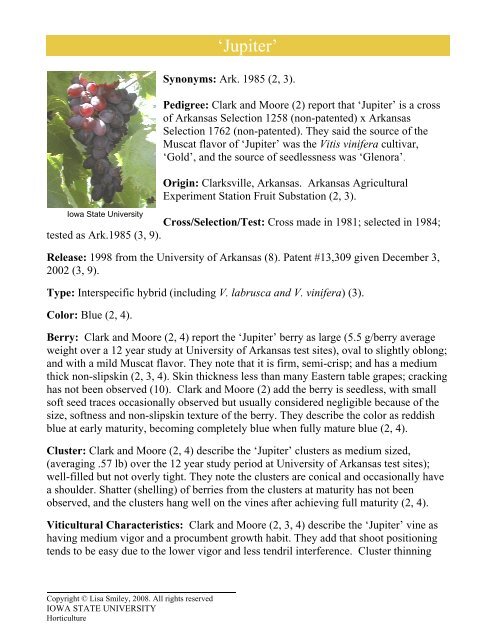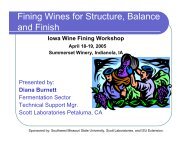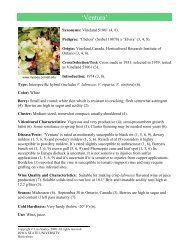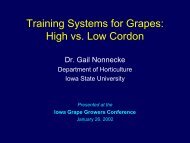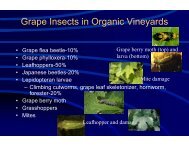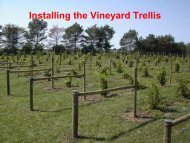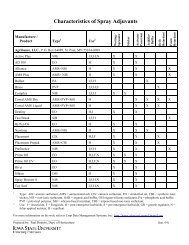'Jupiter' - Viticulture Iowa State University
'Jupiter' - Viticulture Iowa State University
'Jupiter' - Viticulture Iowa State University
You also want an ePaper? Increase the reach of your titles
YUMPU automatically turns print PDFs into web optimized ePapers that Google loves.
‘Jupiter’<br />
Synonyms: Ark. 1985 (2, 3).<br />
Pedigree: Clark and Moore (2) report that ‘Jupiter’ is a cross<br />
of Arkansas Selection 1258 (non-patented) x Arkansas<br />
Selection 1762 (non-patented). They said the source of the<br />
Muscat flavor of ‘Jupiter’ was the Vitis vinifera cultivar,<br />
‘Gold’, and the source of seedlessness was ‘Glenora’.<br />
Origin: Clarksville, Arkansas. Arkansas Agricultural<br />
Experiment Station Fruit Substation (2, 3).<br />
<strong>Iowa</strong> <strong>State</strong> <strong>University</strong><br />
Cross/Selection/Test: Cross made in 1981; selected in 1984;<br />
tested as Ark.1985 (3, 9).<br />
Release: 1998 from the <strong>University</strong> of Arkansas (8). Patent #13,309 given December 3,<br />
2002 (3, 9).<br />
Type: Interspecific hybrid (including V. labrusca and V. vinifera) (3).<br />
Color: Blue (2, 4).<br />
Berry: Clark and Moore (2, 4) report the ‘Jupiter’ berry as large (5.5 g/berry average<br />
weight over a 12 year study at <strong>University</strong> of Arkansas test sites), oval to slightly oblong;<br />
and with a mild Muscat flavor. They note that it is firm, semi-crisp; and has a medium<br />
thick non-slipskin (2, 3, 4). Skin thickness less than many Eastern table grapes; cracking<br />
has not been observed (10). Clark and Moore (2) add the berry is seedless, with small<br />
soft seed traces occasionally observed but usually considered negligible because of the<br />
size, softness and non-slipskin texture of the berry. They describe the color as reddish<br />
blue at early maturity, becoming completely blue when fully mature blue (2, 4).<br />
Cluster: Clark and Moore (2, 4) describe the ‘Jupiter’ clusters as medium sized,<br />
(averaging .57 lb) over the 12 year study period at <strong>University</strong> of Arkansas test sites);<br />
well-filled but not overly tight. They note the clusters are conical and occasionally have<br />
a shoulder. Shatter (shelling) of berries from the clusters at maturity has not been<br />
observed, and the clusters hang well on the vines after achieving full maturity (2, 4).<br />
Viticultural Characteristics: Clark and Moore (2, 3, 4) describe the ‘Jupiter’ vine as<br />
having medium vigor and a procumbent growth habit. They add that shoot positioning<br />
tends to be easy due to the lower vigor and less tendril interference. Cluster thinning<br />
Copyright © Lisa Smiley, 2008. All rights reserved<br />
IOWA STATE UNIVERSITY<br />
Horticulture
‘Jupiter’<br />
may be needed at bloom to improve berry size (6). Eighty five days from bloom to<br />
harvest (5) . ‘Jupiter’ is moderately sensitive to phenoxy-herbicides (2, 4).<br />
Disease/Pests: ‘Jupiter’ is rated as highly susceptible to downy mildew (1, 6) and<br />
powdery mildew (1, 5, 6); moderately susceptible to black rot (1, 5, 6); and slightly<br />
susceptible to anthracnose (1, 6), Botrytis bunch rot (1, 5, 6), and Phomopsis cane and<br />
leaf spot (1, 5, 6). They are uncertain if it is susceptible to crown gall and Domoto (6)<br />
states that it is not sensitive to injury from sulfur or copper applications.<br />
Wine Quality and Characteristics: Used primarily as a table grape. Soluble solids<br />
concentration of ‘Jupiter’ averaged 19.8% over 12 years of study at <strong>University</strong> of<br />
Arkansas test sites (3).<br />
Season: Early Midseason (2) Early to mid-August in <strong>Iowa</strong> (7, 8).<br />
Cold Hardiness: Moderately hardy (-10 to -15° F). Some vine death occurred after<br />
exposure to -26° F in the West Lafayette, Indiana planting (4). Domoto (3) indicated<br />
that the vines are slow to harden off in the fall.<br />
Use: Seedless table, juice.<br />
Notes: Clark and Moore (4) report that ‘Jupiter’ is the fifth cultivar is a series of<br />
seedless table grapes released from the <strong>University</strong> of Arkansas and add the release of<br />
this cultivar will expand the options for eastern table grape growers, specifically<br />
providing a Muscat-flavored seedless table grape.<br />
Literature Cited<br />
1. Bordelon, B, M. Ellis, and R. Weinzerl (editors). 2008. Midwest commercial small fruit & grape<br />
spray guide. (Univ. Arkansas Coop. Ext. Ser.; Univ. of Illinois Ext. ICSG3-08; Purdue Ext. ID-<br />
169; <strong>Iowa</strong> St. Univ. Ext. PM 1375; Kansas St. Univ. Ag Expt. Sta. & Coop Ext. Ser. S-145;<br />
Univ. of Kentucky Coop. Ext. Ser. ID-94; Univ. of Missouri, Missouri St. Univ. MX37; Univ. of<br />
Nebraska-Lincoln Ext.; Ohio St. Univ. Ext. 506B2; Oklahoma Coop. Ext. Ser. E-987; W.<br />
Virginia Univ. Ext. Ser. 865). On: http://www.hort.purdue.edu/hort/ext/sfg/.<br />
2. Clark, J.R., and J.N. Moore. 1999. ‘Jupiter’ seedless grape. HortScience, Vol. 34(7):1297-1299.<br />
3. Clark, J.R., and J.N. Moore. 2002. A grapevine plant named ‘Jupiter’. U.S. Plant Patent No.<br />
PP13,309.<br />
IOWA STATE UNIVERSITY<br />
Horticulture
IOWA STATE UNIVERSITY<br />
Horticulture<br />
‘Jupiter’<br />
4. Clark, J.R., and J.N. Moore. 2000. Horticultural studies 1999. Arkansas Agricultural Experiment<br />
Station, <strong>University</strong> of Arkansas. Research Series 475. Richardson, M.D. and J.R. Clark, editor.<br />
pp. 65-68. On: http://arkansasagnews.uark.edu/475.pdf.<br />
5. Dami, I., B. Bordelon, D. Ferree, M. Brown, M. Ellis, R. Williams, and D. Doohen. 2005.<br />
Midwest grape production guide. Ohio <strong>State</strong> <strong>University</strong> Extension Publication 919-05. On:<br />
http://ohioline.osu.edu/b919/0010.html.<br />
6. Domoto, P. 2008. Grape cultivars for consideration in <strong>Iowa</strong>. On:<br />
http://viticulture.hort.iastate.edu/info/pdf/cultivars08.pdf.<br />
7. Domoto, P., G. Nonnecke, D. Portz, L. Smiley, B. Havlovic, N. Howell, K. Pecinovsky, K.<br />
VanDee, and J. Hannan. 2008. Wine Grape Cultivar Trial Performance in 2007. Ann. Prog. Rept.<br />
– 2007 for Hort. Res. Sta., ISRF07-36:39-45; Armstrong R&D Farm, ISRF07-12; Muscatine<br />
Island R&D Farm, ISRF07-20; Northeast R&D Farm, ISRF07-13; and Southeast R&D Farm,<br />
ISRF07-34. On: http://viticulture.hort.iastate.edu/research/pdf/winegrapecultivar07.pdf.<br />
8. Domoto, P., G. Nonnecke, D. Portz, B. Havlovic and N. Howell. 2008. Grape Cultivar by<br />
Management System Trial Performance in 2007. Ann. Prog. Rept. – 2007 for Hort. Res. Sta.,<br />
ISRF07-36:35-38; and Armstrong R&D Farm, ISRF07-12. On:<br />
http://viticulture.hort.iastate.edu/research/pdf/leopoldgrapecultivar07.pdf .<br />
9. National Grape Registry (NGR) website: http://ngr.ucdavis.edu/. Supported by <strong>University</strong> of<br />
California Agriculture and Natural Resources, Services, and the National Clonal Germplasm<br />
Repository of the USDA Agricultural Research Service.<br />
10. <strong>University</strong> of Arkansas Cooperative Extension Service. Commercial Horticulture: Fruits and<br />
Nuts. Jupiter Grape. On:<br />
http://www.aragriculture.org/horticulture/fruits_nuts/Grapes/jupiter.html.


